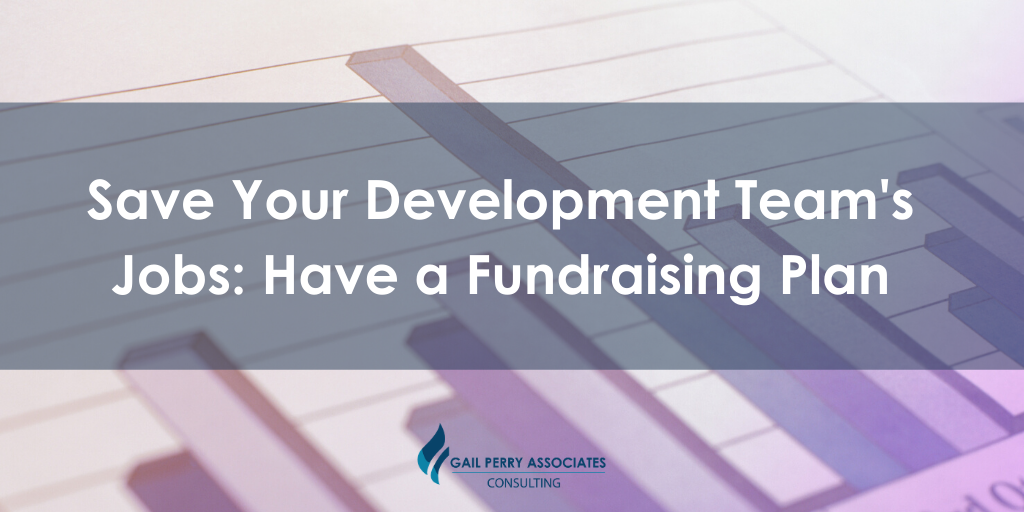Save Your Fundraising Team’s Jobs: Have a Numbers-Based Fundraising Plan!
 Many nonprofits are laying off fundraising staffers these days in order to save money. Are your team’s jobs in jeopardy?
Many nonprofits are laying off fundraising staffers these days in order to save money. Are your team’s jobs in jeopardy?
Here’s how to save your fundraising budget – and jobs – from the chopping block.
Here’s a post from our fundraising plan guru – Dr. Kathryn Gamble:
If you DO NOT have a written fundraising plan, then NOW is the time to write one.
Start today – right now!
Why now? The current crisis is forcing many nonprofits to make difficult financial decisions.
CEOs and CFOs are looking for ways to reduce expenses. Of course, they want to save what they consider mission-essential programs and staff. They look for anything they think could possibly be reduced or eliminated.
That’s why often fundraising is on the block for cutting.
The discussion begins. “We couldn’t do our big event.” “Donors are going to cut back their giving.” “We have to maintain our mission services.” And so on.
You, Director of Development, need to insert yourself in these conversations. How? Your fundraising plan is your ticket.
I want to be clear – you may still have to cut some of your fundraising expenses depending on your nonprofit’s situation. But your written fundraising plan will help you justify your expenses.
Here are the four reasons you must have a written fundraising plan NOW:
1. Demonstrate the revenue streams from fundraising.
Look at your organization’s sources of cash flow. Depending on the type of nonprofit you are, your funding mix (earned income; government contracts/grants; fundraising) will vary. These revenue sources flow into your nonprofit to cover the operating and program expenses.
Your fundraising plan lays out various fundraising revenue streams along with expenses.
Your profitability is quite clear when you compare revenue and the cost to raise a dollar.
2. Show how some fundraising strategies are more profitable than others.
If you face cuts, then you want to identify and keep your most profitable fundraising strategies. Your plan clearly demonstrates which of your strategies is most profitable.
In addition, your plan defines how you measure your results. When you compare investment (costs) to revenue results, again, you are measuring your Return on Investment or ROI.
I was on the phone today with one of our consulting clients – a college president.
He mentioned that he will need to make budget cuts everywhere – including fundraising, saying “We will have to do more with less.”
I responded that you want to know WHICH less to keep and which to chop. Only your fundraising plan can tell you.
3. You can actually predict future results by assessing your past fundraising totals.
When we talk about assessment, we mean you are assessing the numbers – your donor retention; your direct mail results; your major gift potential and more.
Fundraising is based on the numbers. So to plan well, you need to assess how well things are working now, and what dollar results various strategies bring in.
That brings us to the fourth and possibly most critical reason for having a written fundraising plan right now.
4. A plan gives you a clear format for monitoring your progress and adapt when things aren’t working.
In other words, when results don’t meet the dollar goal, then you can adapt, change, or even move to a new tactic.
In this current environment, when a key strategy such as an event has been cancelled, your plan allows you to quickly survey your other strategies so you can capitalize on other giving potential.
If you don’t have a written fundraising plan, how do you create one or make the existing one better?
Here are three steps to get you started.
1. Assess, assess, assess.
Look at your past results. What is your donor retention rate? How many of the donors you sent that last direct mail responded?
2. Set your goals based on your assessment.
For example, if you plan a direct mail to a particular segment of your donors, it is their past giving that will relate to a future goal.
3. Articulate your strategies and tactics by the numbers.
Fundraising is a numbers game. Each tactic you employ is defined by numbers – target audience; value of asks; investment; goal.
The investment decision – the critical conversation with your CEO and CFO.
So, now you have your ticket to a critical conversation about the future of your organization – your fundraising plan. Now you are ready to talk with your CEO and CFO about potential cuts.
These can be emotionally charged conversations. Stay focused on your plan.
Use your plan to inform and discuss the options. Your plan will keep you from starting in a defensive position.
Your strategy in these conversations is to inform choices.
And, you are educating decision makers about your fundraising program. For example, you can clearly connect a potential cut to the correlated drop in revenue.
Bottom Line: With your plan, you are supporting and informing the difficult choices your organization is facing.
You may be giving your organization a real shot at survival and keeping its critical mission in the world.
If you need help creating a fundraising plan for your nonprofit, we can help.
Our Highly Profitable Fundraising Toolkit video course has 100 pages of assessments and planning formats to guide you, and you can check it out at this link.



